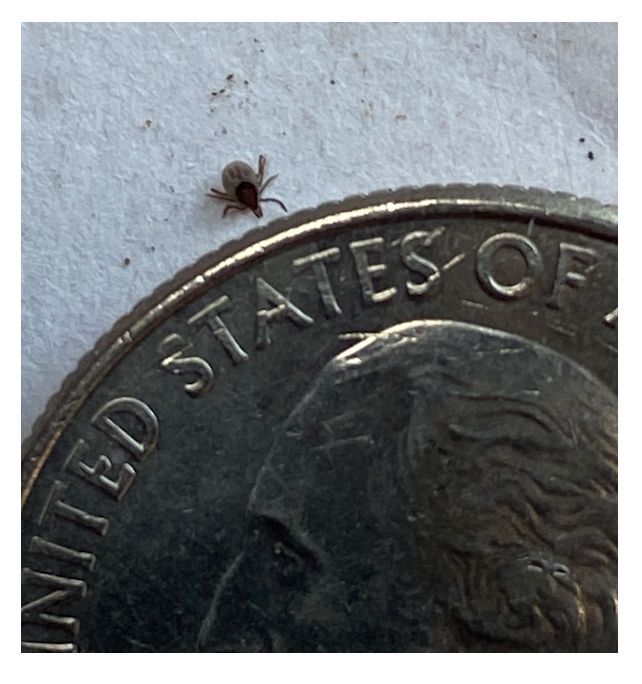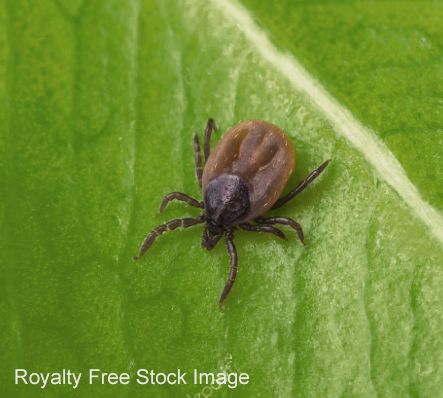A new wave of tick-borne diseases
Unlike Lyme disease, anaplasmosis is lethal in roughly 1 out of 200 of cases

It started with night sweats, but otherwise no obvious symptoms. A few weeks earlier, the Thetford resident in question had joined a second grade class on one of its visits to the Zebedee Headwaters wetland. Although there was no trace of a tick bite, the doctor was concerned and ordered a blood test. The results showed a low white cell count, triggering a further test which lit up positive for anaplasmosis. This was in 2017.
In 2021 the same resident was gardening and pulled off a couple of ticks that were not embedded. No other ticks were found. Two weeks later, she was in the emergency room with extreme exhaustion, headaches, and light-sensitive eyes, but no fever. She did not connect her condition to ticks. However, the ER doctor found extremely low levels of white blood cells and platelets and ordered the “tick panel” test. It came back positive for anaplasmosis.
Anaplasmosis is now the second most common tick-borne disease in Vermont, Lyme disease being number one. Unlike Lyme disease, anaplasmosis is lethal in roughly 1 out of 200 of cases, most often to elderly people or those with compromised health. It must be diagnosed and treated promptly. Symptoms begin 5-21 days after a bite from an infected tick and may include fever, headache, muscle pain, nausea, and cough but rarely a rash. Advanced disease is characterized by respiratory and organ failure.
Vermont has been the US leader in annual incidence of anaplasmosis since 2015, incidence being the number of new cases per unit of population, not a total number of new cases. However, incidence is a measure of the probability of getting a disease.
Tick-borne Lyme disease is common in Vermont. The first sign may be a spreading rash, often with a clear center or “bull’s eye.” Illness starts in 3-5 days post-bite with symptoms like fever, chills, headaches, memory loss, limb and joint pain, and fatigue. If untreated it can become a debilitating disease with severe arthritis and neurological effects.
The VT Department of Health also has concerns about new tick-borne diseases becoming more common in the state. They include borrelia and tularemia caused by bacteria, and babesiosis, related to malaria and caused by a protozoan.
Forty years ago nobody worried about ticks, and even 20 years ago it was uncommon to find one, but now they are a fact of life. Climate change and warming temperatures are major factors enabling ticks to expand northward. Ticks are notable because they transmit more diseases than any other blood-sucking arthropod. They are not insects, but relatives of spiders, scorpions, and mites.
Of the nine species of tick in the US, the black-legged tick (aka deer tick) transmits by far the largest number of diseases, including Lyme disease, anaplasmosis, babesiosis, erlichiosis, relapsing fever, and Powassan virus. This tick has spread from scattered locations to most of the eastern US and southern Canada following the reintroduction and proliferation of white-tailed deer, its most common host. Immature ticks also feed on white-footed mice, deer mice, and other small mammals, but at all stages of development ticks can and do bite humans. Black-legged ticks are adapted to forest and brushy habitat and can live through sub-freezing temperatures (15 degrees F) for a couple of hours. They survive quite nicely under leaf litter in our ever-milder winters, protecting themselves with a natural antifreeze protein. Interestingly, anaplasmosis improves their antifreeze production and enhances their survival.
A Vermont study in 2018 analyzed over 2,000 black-legged ticks collected around the state. It found that 53% carried the bacterium causing Lyme disease, 6% carried anaplasmosis, 4% carried babesiosis, and 2% carried borrelia. What’s more, a tick can carry more than one disease at a time. Five percent had Lyme plus anaplasmosis and 3% had Lyme plus babesiosis.

In addition to black-legged ticks, we have the American dog tick (aka wood tick) that is found in grassy fields and areas with scant tree cover. This species transmits the bacterium that causes tularemia, a disease that is still very rare in Vermont. The brown dog tick transmits Rocky Mountain spotted fever that has not yet been found in Vermont. Squirrel ticks and woodchuck ticks are rarely found outside the dens of their hosts. They both transmit Powassan virus, again extremely rare in the state, but serious and deadly.
The Lone Star Tick, named for the single white spot on its back, is not considered established in Vermont, although it has been recorded in three counties. It transmits erlichiosis and tularemia, both very rare but not unheard of in the state. It also has the dubious distinction of causing red meat allergy in people. With its bite it injects a carbohydrate carrying alpha-gal (galactose-alpha-1,3-galactose) that stimulates the body to form a particular type of antibody (IgE) against the alpha-gal. Meat from mammals also contains alpha-gal, and consuming red meat releases alpha-gal into the circulation where it reacts with the IgE antibodies. The result is a severe, delayed allergic response. Symptoms can include throat or tongue swelling and vomiting. This allergy tends to fade after several years in most affected people.
Many people who contract a tick-borne disease swear they never found a tick on their body. This is probably because ticks vary in size, depending on their stage in the life cycle. A black-legged tick that recently hatched is a larva, a mere speck a fraction of a millimeter across. The larvae are thought to be disease-free. They become disease carriers by feeding on an infected animal, usually a mouse or small mammal. After feeding, the larvae grow into nymphs that are maybe half a millimeter across. Nymphs need to suck blood a second time to mature into breeding adults. Usually the nymph gets it from a deer, but it can be a human. And it’s the bite of a barely visible, bacteria-bearing nymph that is to blame for many a Lyme or anaplasmosis infection where no tick was observed.
Both rodents and deer serve as reservoirs of anaplasmosis and Lyme in the environment. A 2011 study in Minnesota found that 20% of mice were infected with anaplasmosis, while 40% carried Lyme disease, with a co-infection of 14%. Over 80% of chipmunks examined were infected with anaplasmosis and over 70% with Lyme disease, and all animals with Lyme were co-infected with anaplasmosis. The study also found evidence, from deer blood samples contributed by hunters, that deer were infected with anaplasmosis and Lyme disease, although the anaplasmosis strain was not the one that infects mice and humans.
A 2017 article in the Washington Post stated that where Lyme disease is endemic in an area extending from Virginia to Maine, at least half, or even up to 90%, of mice were infected with Lyme disease bacteria.
A loss of biodiversity appears to contribute to the spread of Lyme and other tick-borne diseases. Mice and chipmunks become dominant in areas where biodiversity has declined, for instance around human habitation. A 19-year study in Dutchess County, NY, found a higher proportion of nymphs bearing Lyme disease in forests with many rodents and few predators like bobcats, foxes, opossums or raccoons. By contrast the number of infected nymphs was lowest in locations with denser forest and high predator diversity and number. Interestingly, the proportion of infected nymphs increased in locations where coyotes ousted the other predators.
The size of habitat also matters. A 2003 study showed that the density of infected ticks was three times higher in small areas of forest compared to large forest areas that are incidentally more biodiverse. In Vermont, forest fragmentation by development and roads is a growing concern.
Sorry to say, we can expect new tick-borne diseases as climate change brings the northward expansion of the Lone Star tick and even the Gulf Coast tick. The symptoms of tick-borne diseases are very variable, so when in doubt consult a doctor. Otherwise the best we can do is protect ourselves. Be aware that ticks, particulary the black-legged tick, are active when temperatures are above freezing and there is no snow cover. General precautions include avoiding areas of high grass, leaf litter, and brush; walking down the center of trails; using tick repellents; wearing tick-repellent clothing, especially socks; taking a hot shower that dislodges ticks after activities like gardening; and regularly checking our bodies for ticks. Also be aware that pets like dogs and cats bring ticks indoors. So check them, too.

